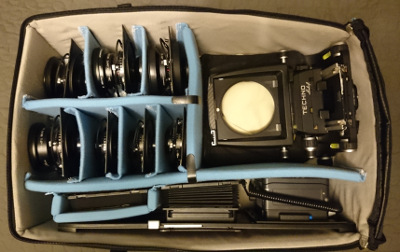I think both views are valid, and it's a personal thing. Of course you're right that you can use a speedy DSLR like a large format camera if you like to, and indeed that was how I did most of the time when I used my Canon for landscape photography. But it's about what you enjoy using and what you resonate with. Of course there's no difference to drive a classic car or my tiny Toyota when going from A-to-B, you'll get there with both alternatives. Still some find enjoyment of the classic car, despite that it may actually be less comfortable.
I get a bit stressed by all this electronics and hunt for ever-improving image quality and convenient features. Reacting against it, making photographs in a classic very basic way, I see the image projected on the ground glass make my movements, put a sensor there and register the image, done.
I also got a bit stressed from having a camera that instantly can react to all opportunities. I like to narrow it down. Of course I could do it in my mind only, but it just
feels better to have a system that so well aligns with how I want to make images.
And one thing I'm 100% sure about, once medium format cameras work the same as smaller cameras and the same price difference is still maintained, then I'm out. I do not believe that you sacrifice any meaningful image quality by choosing the smaller format these days, and if handling is just too similar the motivation to stay in won't be there for me any longer. (I must have a reason to not continue to use my current system first though...)
I'm very rational and "scientific" when it comes to image quality, but when it comes to handling and shooting process I'm the emotional type. I don't make commercial photography though, my intention is to make art, and using gear that I like how it handles and shoots help me getting "in the mood", get more connected to the scene etc. This is something personal, no rights or wrongs. Would I do commercial photography I would probably take on a more rational approach there and look at what solution that would be most efficient to get results for the client.
If gear doesn't matter at all to you, congratulations that's good, then you only need to look at raw performance and what you actually need in technical terms. With your very rational view on gear I'm very surprised that you are still shooting film. Why is that?
Oh, I'm a little bit of both also in this. I don't like to be limited by focal lengths, I don't like to be limited in movements. To my Linhof Techno I have 35, 47, 60, 72, 90, 120 and 180 all Schneider Digitar, thanks to their compact symmetrical design and lens boards it all fits in my camera backpack which I carry with me. So from my shooting perspective my camera is more flexible in opportunities than any other system I could come up with. But I can't shoot hand-held, and I can't shoot any suddenly appearing wild-life, and it feels rather relaxing.
(In theory medium format should be the gear that you need to update the least often, and thus a good alternative to tech-stressed guys like myself. However I don't think it has worked out so well with tech cams, it's changing quicker than most formats I've seen. But it's still true in one sense, the gear I have today matches or even exceeds 4x5" in quality quite well, and who needs more? So you don't really need to upgrade if you can battle the temptation.)

